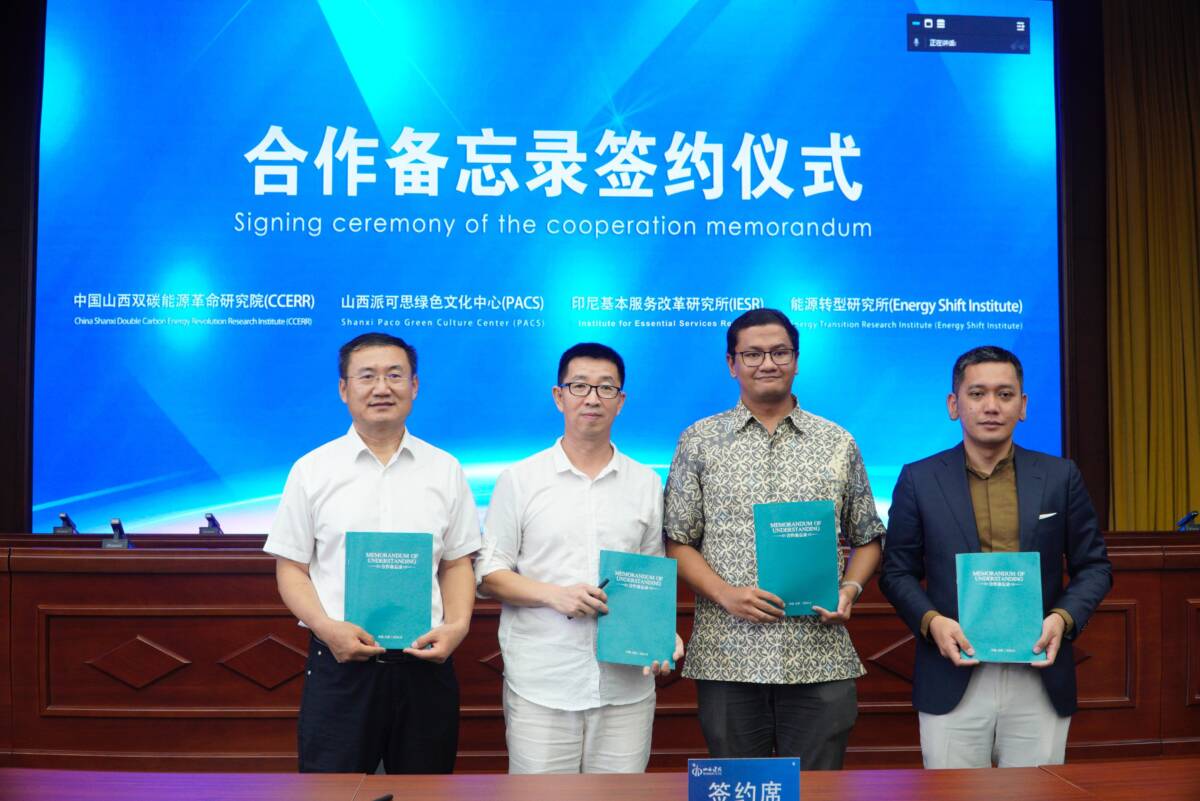Wira A. Swadana, Green Economy Program Manager of IESR, signed a Memorandum of Understanding (MoU) to promote low-carbon energy development and collaboration in energy transition, carbon neutrality, and energy revolution (01/08/2024).Taiyuan, 2nd August 2024 – South Sumatra and East Kalimantan, Indonesia’s two largest coal-producing regions, are set to be significantly impacted by the global shift to renewable energy. The increasing international commitment to transition away from fossil fuels to reach net-zero emission targets, including coal phase down and out and scaling up the expansion of renewable energy sources, is anticipated to decrease global coal demand and consequently Indonesia’s coal export. In response, the Indonesian government and the provincial government of South Sumatra and East Kalimantan must promptly develop a comprehensive development and economic strategy to cope with impacts from the coal downturn. This strategy should prioritize sustainable alternative economic development, advancing human development, renewable energy technology innovation, advanced carbon material non-combustion processing, and robust policy support and assistance to impacted communities and workers.
The Shanxi Carbon-Peak-Carbon-Neutral Energy Revolution Research Institute (CCERR), in partnership with People of Asia for Climate Solutions (PACS), Institute for Essential Services Reform (IESR), organized the Second Coal-free Future Discussion and China-Indonesia Energy Transition Field Trip from July 29 to August 1, 2024, in Shanxi Province, China. The visit brought together representatives from the governments of South Sumatra and East Kalimantan to study Shanxi’s progress in energy transition. As China’s leading coal-producing province, Shanxi held coal reserves of 43.31 billion tons in 2022, accounting for 23.3% of China’s total coal reserves.
Zhang Cheng, Executive Director of CCERR, stated that the Chinese government has also put forward the dual carbon goals of striving to peak carbon dioxide emissions before 2030 and achieving carbon neutrality before 2060, strictly controlling and gradually reducing coal consumption.
“China and Indonesia have enormous potential for cooperation in traditional energy transition and renewable energy, including technology transfer, project investment, and capacity building. The two countries’ energy cooperation is highly complementary and has broad prospects,” Cheng explained.
Furthermore, Xiaojun Wang, Executive Director of PACS, emphasized the critical role of renewable energy technology in expediting the energy transition within coal-producing regions. According to Wang, this visit provided an opportunity for East Kalimantan and South Sumatra to observe Shanxi Province’s strides in renewable energy technology development.
“While renewable energy technology in Shanxi is still developing compared to the province’s coal and heavy industries, its adoption in coal regions often encounters challenges due to perceived technical risks and significant investment needs. To address these issues, bolstering renewable energy technology innovation capabilities through the establishment of scientific research institutions and high-tech enterprises, as well as implementing structured training programs, is essential,” Wang explained.
Fabby Tumiwa, Executive Director of IESR, stated that as the transition away from coal accelerates, strategies to mitigate the economic and social consequences of coal-producing regions should become a priority in the upcoming long-term and medium-term development plans at the national and subnational levels. The Indonesian government must collaborate closely with local authorities in crafting sustainable economic development plans and deploying them immediately.
“The government should swiftly identify promising alternative economic sectors while simultaneously enhancing community financial literacy and preparing coal industry workers for sustainable industries. Learning from major coal producer provinces, like Shanxi in China, could inspire Indonesian national and subnational governments to envision transformative changes it shall have in the near future and plan for the post-coal economy,” Fabby added.
Fabby also underscored the significance of multi-stakeholder collaboration across regional, national, and international platforms to minimize the economic and social impacts of energy transition and facilitate knowledge exchange among coal-producing regions transitioning to clean energy.
To strengthen energy transition knowledge in coal-producing regions, CCERR, PACS, and IESR have signed a Memorandum of Understanding (MoU) to promote low-carbon energy development and collaboration in energy transition, carbon neutrality, and energy revolution (01/08/2024). Wira A. Swadana, Green Economy Program Manager of IESR, emphasized that this partnership offers a valuable platform for China and Indonesia to share expertise and best practices in achieving a sustainable energy future and fostering sustainable industries.
The China-Indonesia Energy Transition Field Trip included visits to five key locations. First, Shanxi Meijin Energy, a leading independent commodity coke producer with a comprehensive industrial chain encompassing coal, coke, gas, chemicals, and hydrogen. Second, Shanxi Shuangliang Renewable Energy Industry Group, a renewable energy technology pioneer holding 238 patents and specializing in industrial waste heat recovery and geothermal energy development. Third, China Energy Engineering Group Shanxi Electric Power Construction, focused on energy and electric power planning, engineering consulting, and construction. Fourth, Dayu Toll Station Solar Storage, Charging and Supply Integrated Demonstration Project and Green Valley Carbon Neutral Environmental Protection Science and Technology Park. Fifth, Taiyuan Design Research Institute for Coal Industry.

